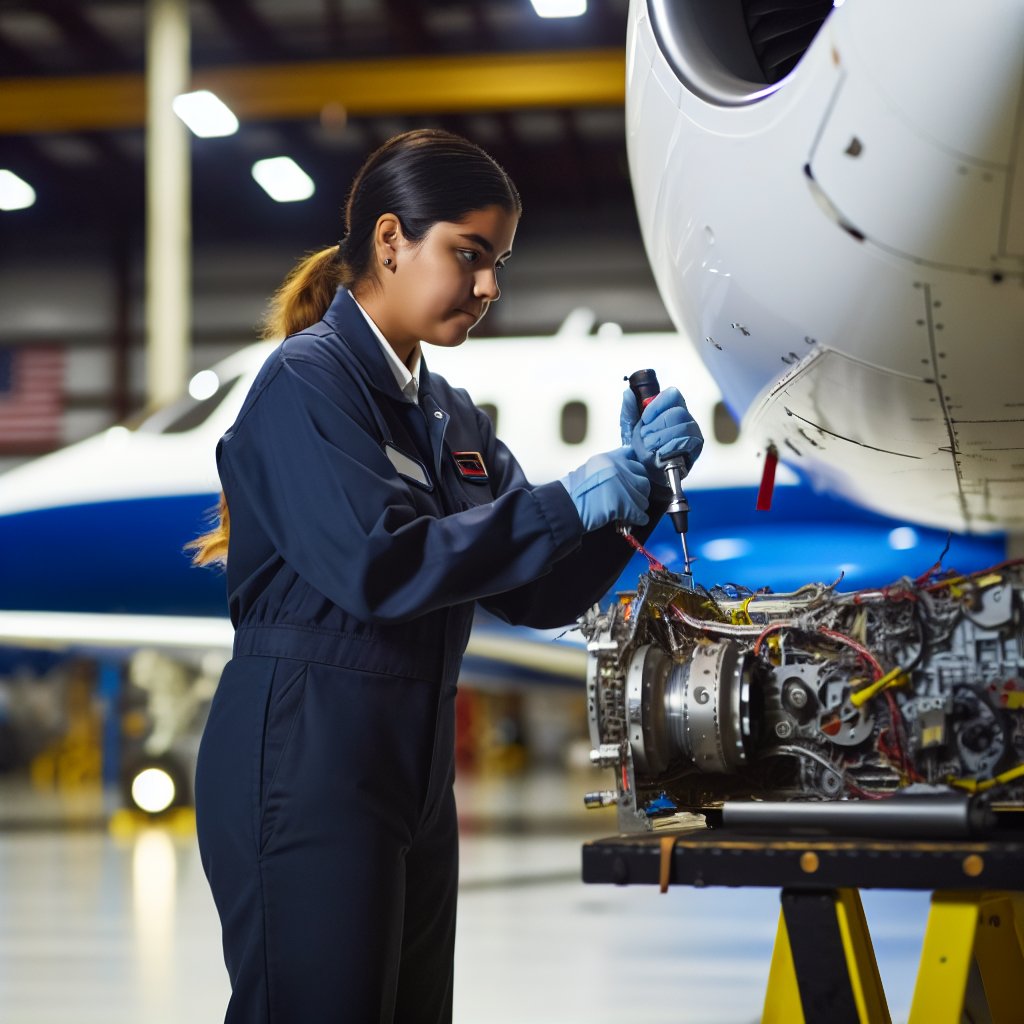Introduction:
An Aviation Maintenance Technician (AMT) plays a crucial role in ensuring the safety and functionality of aircraft.
Their diverse tasks and responsibilities are vital in the aviation industry.
Starting the Day:
AMTs typically start their day by reviewing maintenance schedules and work orders.
They inspect aircraft for any signs of damage or wear.
Performing Inspections:
Once the inspections are complete, AMTs perform routine maintenance tasks such as changing oil, checking fluid levels, and replacing worn parts.
Diagnosing and Repairing:
If an issue is detected during inspections, AMTs use diagnostic tools to identify the problem and make necessary repairs to ensure aircraft safety.
Documenting Work:
AMTs are meticulous in documenting all maintenance and repairs performed on the aircraft.
Accurate records are essential for regulatory compliance.
Testing Systems:
After maintenance work is completed, AMTs run tests on various systems to ensure they are functioning properly.
They must verify the aircraft’s safety before it can fly.
Collaborating with Team:
AMTs often work in teams to efficiently handle maintenance tasks.
Effective communication is key to ensure work is done accurately and timely.
Continuous Learning:
As technology advances, AMTs must stay updated on the latest aircraft systems and maintenance techniques.
They attend training sessions to enhance their skills.
End of the Day:
At the end of the day, AMTs conduct a final inspection to ensure the aircraft is safe for its next flight.
They take pride in their work knowing they contribute to passenger safety.
Job Responsibilities:
As an Aviation Maintenance Technician (AMT), the daily tasks involve inspecting, repairing, and maintaining aircraft to ensure their safe operation.
Following safety protocols and regulations is paramount in aviation maintenance.
This ensures the safety of passengers, crew, and the aircraft itself.
AMTs perform a wide range of maintenance and repair work on various aircraft components.
Transform Your Career Today
Unlock a personalized career strategy that drives real results. Get tailored advice and a roadmap designed just for you.
Start NowThis includes engines, landing gear, avionics, and more.
Specific Tasks
- Inspecting aircraft for defects and wear.
- Repairing or replacing damaged parts.
- Testing aircraft systems for functionality.
- Conducting routine maintenance checks.
- Documenting all work performed.
AMTs must adhere to strict regulations set by aviation authorities.
This ensures that all maintenance work is done correctly and safely.
By meticulously inspecting and repairing aircraft, AMTs play a crucial role in ensuring the safety of everyone on board.
Attention to detail and precision are essential qualities for AMTs.
Any oversight or mistake could have serious consequences in aviation.
AMTs must stay updated with the latest technologies and procedures in aviation maintenance.
This is important to enhance their skills and knowledge.
Working closely with other aviation professionals, such as pilots and engineers, is important.
This collaboration helps AMTs effectively maintain aircraft.
AMTs must be prepared to respond to aircraft maintenance issues at any time.
Flights operate around the clock.
Being an Aviation Maintenance Technician comes with a unique work environment that requires adaptability and attention to detail.
Typical Work Environment of an AMT:
- Hangars: AMTs often work in hangars where aircraft are housed for maintenance and repairs.
- Repair Stations: They can also be found working in repair stations that specialize in fixing aircraft components.
- Runway: Some AMTs may need to work directly on the runway to perform inspections or repairs on grounded aircraft.
Necessity of Working in Hangars, Repair Stations, or on the Runway:
- Hangars provide a controlled environment for AMTs to work on aircraft without exposure to external elements.
- Repair stations have specialized equipment and tools needed to repair and maintain aircraft effectively.
- Working on the runway allows AMTs to address immediate maintenance issues that may cause delays in flight schedules.
Potential Challenges of Working in Varying Weather Conditions:
- Extreme Temperatures: AMTs may have to work in extremely hot or cold conditions, which can affect their productivity.
- Weather Delays: Severe weather conditions such as storms or heavy rain can disrupt maintenance schedules and deadlines.
- Safety Concerns: Working in adverse weather conditions can pose safety risks for AMTs, requiring extra precautions and protective gear.
Despite the challenges, Aviation Maintenance Technicians are trained to handle different work environments and ensure that aircraft are maintained to the highest standards for safe operations.
Delve into the Subject: Safety Protocols for Aviation Maintenance Technicians
Daily Routine:
As an Aviation Maintenance Technician (AMT), every day is a new challenge filled with excitement and responsibility.
Let’s take a walk through a typical day in the life of an AMT:
Morning Routine:
- Start the day by reviewing maintenance schedules and work orders.
- Prepare tools, equipment, and safety gear for the day’s tasks.
- Attend morning briefing to discuss priorities and assignments.
Adhering to strict schedules and deadlines is crucial in the aviation industry.
Transform Your Career Today
Unlock a personalized career strategy that drives real results. Get tailored advice and a roadmap designed just for you.
Start NowAny delay in maintenance can lead to serious consequences, including flight delays or even accidents.
AMTs must work efficiently and effectively to ensure that aircraft are safe and operational at all times.
Conducting Inspections:
- Perform detailed inspections of aircraft components and systems.
- Use specialized equipment and tools to identify potential issues.
- Document findings and create reports for maintenance records.
Repair and maintenance tasks require precision and attention to detail.
AMTs follow strict procedures and guidelines to ensure that all work is done according to industry standards.
Safety is paramount, and any deviation from protocols can have serious consequences.
Repair and Maintenance:
- Address any identified issues promptly and efficiently.
- Replace or repair damaged components using approved methods.
- Test systems and components to ensure proper functionality.
After completing repairs, AMTs conduct thorough inspections to verify the quality of work.
They must test all systems and components to ensure they meet safety standards and perform as intended.
Attention to detail is key in this phase of the maintenance process.
The daily routine of an Aviation Maintenance Technician is a complex and demanding one.
From inspections to repairs and maintenance, AMTs play a crucial role in ensuring the safety and airworthiness of aircraft.
Adhering to strict schedules and deadlines is essential, as any oversight can have serious implications.
Attention to detail, precision, and dedication are qualities that define a successful AMT in the aviation industry.
Delve into the Subject: Packaging Engineer vs. Industrial Engineer
Tools and Equipment Used by Aviation Maintenance Technicians
As an Aviation Maintenance Technician (AMT), the job requires the use of various tools and equipment to ensure the safe operation of aircraft.
Here are some of the tools and equipment commonly used by AMTs:
Hand Tools
- Screwdrivers: Used for tightening or loosening screws in various components of the aircraft.
- Pliers: For gripping, bending, and cutting wires or cables.
- Wrenches: Used for turning nuts and bolts to secure parts in place.
- Hammers: For driving or removing stubborn components.
- Sockets and Ratchets: To tighten or loosen nuts and bolts quickly.
- Torque Wrenches: Used to apply specific torque to fasteners according to manufacturer specifications.
- Aviation Snips: For cutting and shaping sheet metal.
- Wire Strippers: Used to strip the insulation from wires for maintenance or repair.
Power Tools
- Drills: Used for making holes in various materials.
- Grinders: For smoothing out rough edges or cutting metal.
- Impact Wrenches: Used for fastening or removing bolts quickly.
- Rivet Guns: Used to install rivets for securing components together.
- Heat Guns: For applying heat to loosen adhesive bonds or shrink tubing.
- Dremel Tools: Used for precision cutting, grinding, and sanding tasks.
- Hydraulic Power Units: For operating hydraulic tools and equipment.
Specialized Training for Operating Tools
It is important for AMTs to undergo specialized training on the proper operation of these tools to ensure safety and efficiency in maintenance tasks.
Training typically includes instruction on how to handle tools safely, use them correctly, and maintain them in good working condition.
AMTs learn about the specific applications of each tool and the importance of following manufacturer guidelines for their operation.
They are also trained on how to calibrate tools properly to prevent errors in maintenance procedures that could compromise aircraft safety.
Importance of Proper Maintenance and Care of Tools
Proper maintenance and care of tools are crucial for ensuring their longevity and effectiveness in aircraft maintenance tasks.
Transform Your Career Today
Unlock a personalized career strategy that drives real results. Get tailored advice and a roadmap designed just for you.
Start NowAMTs are responsible for keeping their tools clean, organized, and in good working order to prevent accidents and errors during maintenance procedures.
Regular inspection and calibration of tools are essential to ensure that they are functioning correctly and providing accurate results.
AMTs must also store tools properly in designated areas to prevent damage or loss.
Proper tool maintenance contributes to the overall safety and quality of aircraft maintenance operations.
See Related Content: Work Environment for Transportation Analysts
Training and Certification
Educational Requirements:
- High school diploma or equivalent is required to become an Aviation Maintenance Technician (AMT).
- Some employers may prefer candidates with formal training from an FAA-approved aviation maintenance technician school.
- On-the-job training may also be provided by employers to develop the necessary skills and knowledge.
Training Programs and Certifications:
- AMTs must complete a Federal Aviation Administration (FAA)-approved training program to obtain certification.
- There are several types of certifications available, including Airframe, Powerplant, and Airframe and Powerplant ratings.
- Each certification requires passing written and practical exams to demonstrate proficiency in aircraft maintenance.
Ongoing Professional Development:
- AMTs are required to participate in ongoing training and education to stay updated on industry standards and regulations.
- The FAA may also require periodic renewal of certifications through refresher training and exams.
- Professional development opportunities may include workshops, seminars, and online courses to enhance skills and knowledge.
Delve into the Subject: Key Performance Metrics for Freight Agents

Collaboration and Communication:
Working as an Aviation Maintenance Technician (AMT) requires a high level of teamwork and collaboration among colleagues.
AMTs often work in a fast-paced and high-pressure environment where clear communication is key to ensuring the safety and efficiency of aircraft maintenance.
Importance of Teamwork and Collaboration Among AMTs:
- AMTs frequently work in teams to inspect, repair, and maintain aircraft.
- Teamwork ensures that tasks are completed efficiently and accurately.
- Collaboration allows AMTs to share knowledge and expertise, improving overall performance.
- AMTs rely on each other to deliver high-quality maintenance services.
Effective Communication with Colleagues and Supervisors:
- Clear communication is essential for AMTs to coordinate tasks and prioritize work.
- AMTs must communicate effectively with supervisors to report progress and address any issues.
- Open and honest communication fosters trust and a positive work environment.
- AMTs should be able to provide and receive feedback constructively.
Role of AMTs in Ensuring Clear and Accurate Communication Regarding Aircraft Maintenance:
- AMTs are responsible for documenting maintenance procedures and findings accurately.
- Clear documentation ensures that all team members are informed about the status of maintenance tasks.
- AMTs must communicate any safety concerns or issues promptly to avoid potential risks.
- Accurate communication helps prevent errors and ensures compliance with regulatory standards.
Collaboration and communication are fundamental aspects of an Aviation Maintenance Technician’s role.
By working together effectively and communicating clearly, AMTs can ensure the safety and airworthiness of aircraft while maintaining a productive and harmonious work environment.
Occupational Hazards:
As an Aviation Maintenance Technician (AMT), it is essential to be aware of the potential hazards that come with the job.
Here are some occupational hazards faced by AMTs:
- Noise Exposure: Working with aircraft engines and machinery can expose AMTs to high levels of noise, leading to hearing damage over time.
- Chemical Exposure: AMTs are often required to handle various chemicals and solvents, which can be harmful if proper safety precautions are not taken.
- Electrical Hazards: Working with electrical systems in aircraft can put AMTs at risk of electrical shocks or burns.
- Falling Hazards: Climbing ladders and working at heights while performing maintenance tasks poses a risk of falls for AMTs.
- Lifting and Ergonomic Hazards: Moving heavy aircraft parts and equipment can lead to strains and musculoskeletal injuries if proper lifting techniques are not followed.
Safety Protocols and Measures:
In order to mitigate these risks, strict safety protocols and measures are put in place in aviation maintenance facilities.
Some of the safety practices include:
- Personal Protective Equipment (PPE): AMTs are required to wear proper PPE such as gloves, goggles, ear protection, and safety helmets to protect themselves from hazards.
- Training and Certification: Proper training and certification are essential for AMTs to ensure they have the necessary skills and knowledge to perform their jobs safely.
- Regular Safety Inspections: Routine safety inspections of tools, equipment, and work areas are conducted to identify and address potential hazards.
- Emergency Response Plans: Aviation maintenance facilities have emergency response plans in place to handle accidents or incidents promptly and efficiently.
- Safety Culture: Promoting a culture of safety among staff members is crucial to ensuring that everyone prioritizes safety in all aspects of their work.
Importance of Prioritizing Safety:
It cannot be stressed enough how important it is for AMTs to prioritize safety in their work.
The consequences of neglecting safety measures can be severe, not only for the individual AMT but also for the entire aviation maintenance team and the passengers who rely on the aircraft.
By adhering to safety protocols, taking necessary precautions, and staying vigilant, AMTs can protect themselves from potential hazards and contribute to a safer working environment for everyone involved in aviation maintenance.
Transform Your Career Today
Unlock a personalized career strategy that drives real results. Get tailored advice and a roadmap designed just for you.
Start NowAviation Maintenance Technicians: Dynamic and Essential Roles
A day in the life of an Aviation Maintenance Technician is dynamic and demanding.
Their work involves conducting routine inspections and troubleshooting complex issues.
AMTs play a crucial role in ensuring the safety of aircraft and passengers.
They demonstrate unwavering dedication and expertise in their craft.
Working tirelessly, they keep planes in top condition.
Their meticulous attention to detail and adherence to strict safety protocols are paramount.
AMTs are the unsung heroes of the aviation industry.
They quietly work behind the scenes to ensure that every flight is safe and smooth.
Their expertise and commitment are essential in maintaining aircraft integrity.
AMTs uphold the highest standards in aviation safety.
As we reflect on their vital role, let us appreciate their hard work.
Their efforts ensure that air travel remains one of the safest modes of transportation.
Next time you board a plane, acknowledge the expertise of AMTs.
They work tirelessly to keep us safe in the skies.




